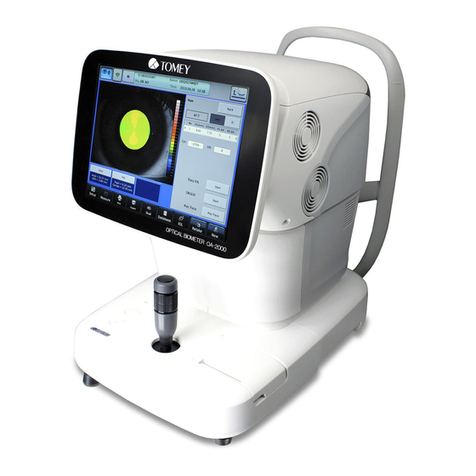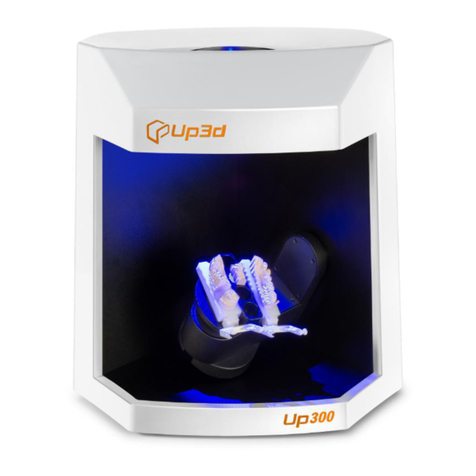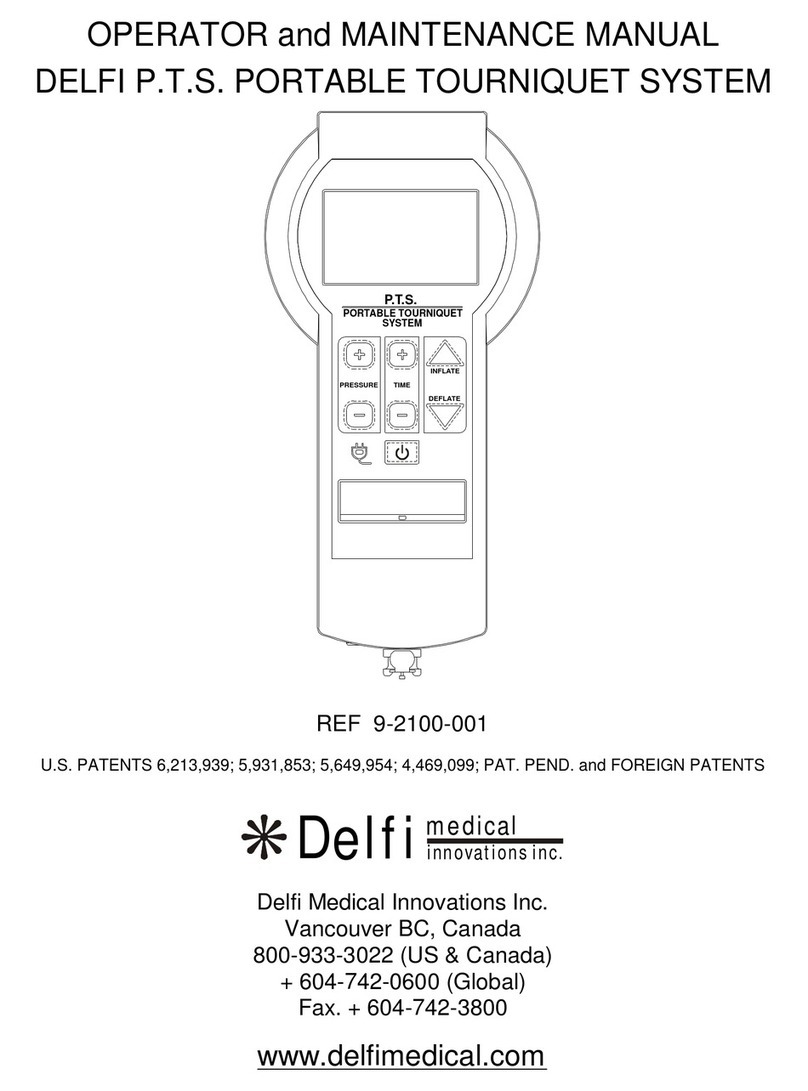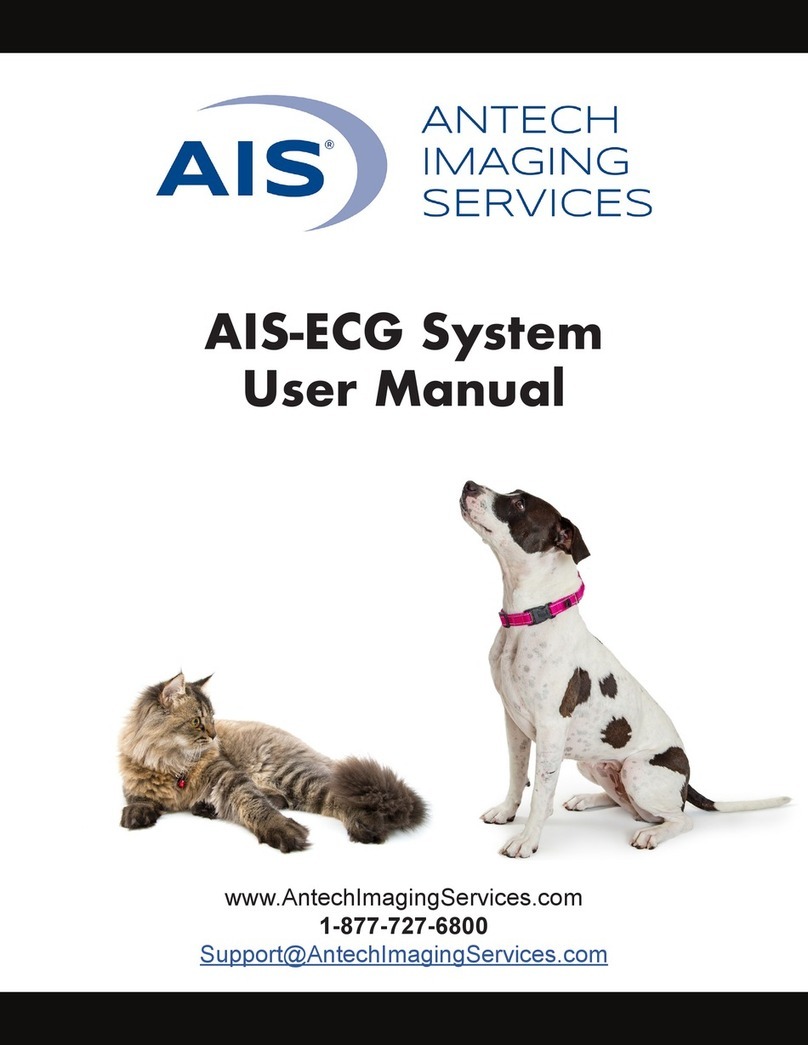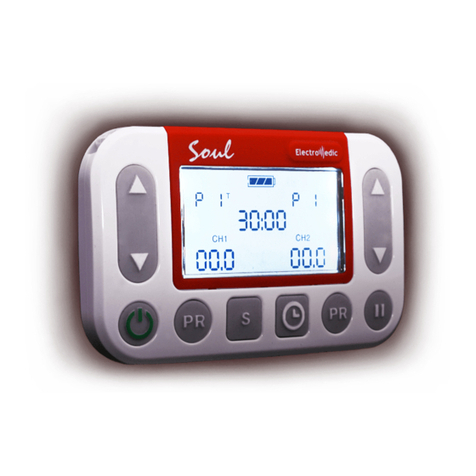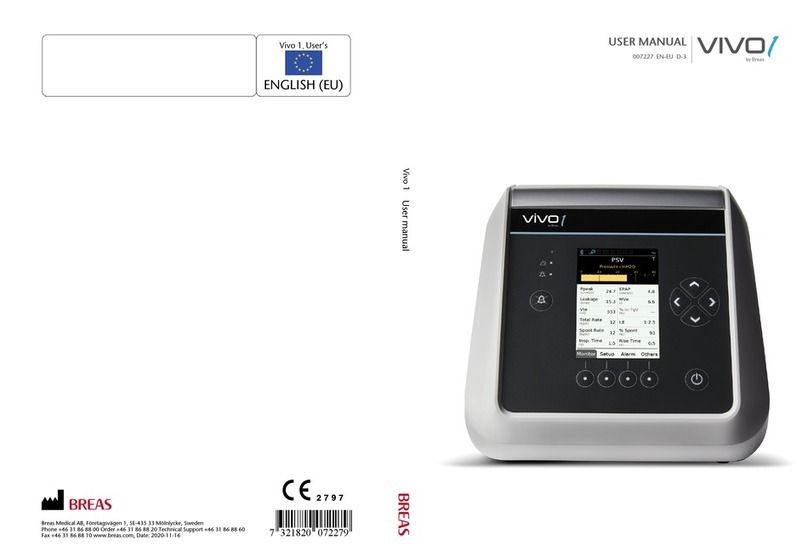MIL'S PRO2XY Installation manual

START-UP AND MAINTENANCE INSTRUCTIONS
MIL'S SAS
15 rue de Genève 69 746 GENAS Cedex - FRANCE
Téléphone + 33 (0)4 72 78 00 40 Télécopie + 33 (0)4 78 00 82 34
www.mils.fr e-mail : sales@mils.fr
519211-22
07/2020
PRO2XY
OXYGEN CONCENTRATOR
Production line for 5- or 9-bar networks
First apposition of the EC marking
2009

Specifications are subject to change without notice.
This document may not be forwarded or reproduced without authorisation from MIL’S SAS company.
Failure to respect this requirement may lead to prosecution.

PRO2XY OXYGEN CONCENTRATOR
519211-22 1
EN
CONTENTS
INTRODUCTION............................................................................................................................................................4
1.1 Specification plate ................................................................................................................................................................4
SAFETY INFORMATION.................................................................................................................................................4
2.1 Oxygen ..................................................................................................................................................................................4
2.2 Cleanliness of the components.............................................................................................................................................4
2.3 Safety relief valve..................................................................................................................................................................5
SYSTEM DESCRIPTION ..................................................................................................................................................5
3.1 General .................................................................................................................................................................................5
3.2 Schematic diagram for PRO2XY concentrator without Booster ............................................................................................6
3.2.1 Single production line on 5-bar network ...............................................................................................................6
3.2.2 Multiple-line production on 5-bar network ...........................................................................................................7
3.3 PRO2XY concentrator with Booster schematic diagram........................................................................................................8
3.3.1 Single production line on 9-bar network ...............................................................................................................8
3.3.2 Multiple-line production on 9-bar network ...........................................................................................................9
3.3.3 Electric Low-Pressure Booster .............................................................................................................................10
3.4 Description of remainder....................................................................................................................................................10
DIMENSIONS.............................................................................................................................................................. 10
4.1 Dimensions PRO2XY OX3 ➔OX16 oxygen concentrators ..................................................................................................10
4.2 Dimensions PRO2XY OX26/OX32 oxygen concentrators.....................................................................................................11
4.3 Dimensions of oxygen receivers for PRO2XY OX3 ➔OX16 oxygen concentrators.............................................................11
4.4 Dimensions of oxygen receivers for PRO2XY OX26/OX32 oxygen concentrators ...............................................................12
4.5 Dimensions pressure reducing lines ...................................................................................................................................12
SPECIFICATIONS TABLE .............................................................................................................................................. 12
CHOICE OF ROOM ......................................................................................................................................................13
6.1 Compressor room ventilation .............................................................................................................................................13
6.2 Concentrator room ventilation...........................................................................................................................................15
6.3 Recommendations and precautions for installation...........................................................................................................15
AIR PRODUCTION UNIT .............................................................................................................................................. 16
7.1 Air quality............................................................................................................................................................................16
7.2 Air production unit architecture .........................................................................................................................................16
7.3 Regulation...........................................................................................................................................................................17
ELECTRICAL CONNECTIONS ........................................................................................................................................18
8.1 Connection HOSPITAIR PACK S / PROCOM 2 Concentrator ................................................................................................18
8.2 Communication between each concentrator .....................................................................................................................19
8.3 Micro cuts / Switch off by the master switch .....................................................................................................................19
CONNECTIONS ........................................................................................................................................................... 20
9.1 Skills, training and qualification requirements ...................................................................................................................20
9.2 Start of work .......................................................................................................................................................................20
9.3 Optional receiver ................................................................................................................................................................20
9.4 Pipes, flexible hoses and fittings .........................................................................................................................................20
9.5 Brazing of piping .................................................................................................................................................................21
9.6 Controls during and after installation of the pipes .............................................................................................................21
PNEUMATIC CONNECTIONS ....................................................................................................................................... 21
10.1 Air unit pneumatic connections..........................................................................................................................................21
10.2 O2concentrator pneumatic connections............................................................................................................................22
10.2.1 Pneumatic connection PRO2XY - 5bar..................................................................................................................22
10.2.2 Pneumatic connection PRO2XY - 9bar..................................................................................................................23
OPERATION................................................................................................................................................................ 25
11.1 Commissioning: 5-bar and 12-bar version ..........................................................................................................................25
11.2 Commissioning for the first time: 5-bar and 12-bar version...............................................................................................25
11.3 Operating under control of single-line concentrator without booster (5-bar version).......................................................25
11.4 Operating under control of multiple-line concentrator without booster (5-bar version)...................................................25
11.5 Operating under control of single-line concentrator with LP booster (12-bar version) .....................................................26
11.6 Operating under control of multiple-line concentrator with LP booster (12-bar version) .................................................26

PRO2XY OXYGEN CONCENTRATOR
2 519211-22
EN
CONTROL OF TWO COMPRESSORS FOR A PRO2XY CONCENTRATOR .......................................................................... 27
12.1 Schematic diagram .............................................................................................................................................................27
12.2 Operation............................................................................................................................................................................27
12.3 MILLENIUM description ......................................................................................................................................................27
12.3.1 Parameters (line n°4)...........................................................................................................................................27
GAS ANALYSERS (OPTIONAL) .....................................................................................................................................28
13.1 Regulation...........................................................................................................................................................................28
13.2 Oxygen concentrator and network sensors with 4-20mA output.......................................................................................28
13.3 Other oxygen concentrator sensor with 0-1V output.........................................................................................................28
13.4 Calibration of sensors .........................................................................................................................................................29
13.5 Reference gas value: ...........................................................................................................................................................30
CLEANING AND MAINTENANCE.................................................................................................................................. 30
14.1 PRO2XY 5-bar (without LP booster) and 12-bar (with LP booster) Concentrator................................................................31
14.2 Low-pressure electric booster ............................................................................................................................................31
14.3 Pressure reducing assembly - 12 bar version (with LP booster) .........................................................................................31
14.4 MV type screw compressors...............................................................................................................................................31
14.5 SEC7OX-AD5xxx type adsorption dryer for Hospitair Pack S...............................................................................................31
PROCOM 2 WITH BACK-UP 24V –OPTIONAL .............................................................................................................. 32
15.1 Description..........................................................................................................................................................................32
15.2 Start-up...............................................................................................................................................................................32
15.3 Maintenance.......................................................................................................................................................................32
OXYGEN RECEIVERS ................................................................................................................................................... 33
PROCOM 2 .................................................................................................................................................................33
TRAINING...................................................................................................................................................................33
CLEANING ..................................................................................................................................................................33
END OF LIFE OF THE MEDICAL DEVICE ........................................................................................................................33
ELECTROMAGNETIC COMPATIBILITY ..........................................................................................................................34

PRO2XY OXYGEN CONCENTRATOR
519211-22 3
EN
MEANING OF SYMBOLS USED IN THIS MANUAL
Symbols are used in this manual to help you understand them and to indicate particular points which you need to act upon or
consider. Those symbols are:
Reading symbol: to refer to the operator manual / instructions manual.
Danger symbol: This symbol represents the DIN 4844 symbol (hazard warning); it warns of a hazard which could result in
death or injury, along with damage to the machine. This symbol must be observed by all personnel working on this machine.
Regulations on safety in the workplace must be observed.
Environmental protection symbol: This symbol serves as a reminder to sort waste during maintenance operations, to store
it in a safe place, and to dispose of it with due care for the environment.
Dustbin on wheels barred of a cross symbol: This symbol indicates that the equipment should not be thrown with domestic
waste and is subject to selective collection.
Symbol prohibition to lubricate: This pictogram indicates prohibition to use grease or lubricant.
Non-ionizing radiation hazard symbol:This pictogram informs of a risk or a danger related to non-ionizing radiations.
Medical Device: The product is a medical device.
Additional pictograms on the oxygen concentrator
Mandatory:
use noise protection
(ISO 7010-M003)
Mandatory:
read operator
instructions
(ISO 7000-M002)
Warning:
risk or danger of
possible presence of
combustion agent
Warning:
risk of electric shock
(ISO 7010-W012).
Warning:
do not touch hot
surfaces
(danger of burns)
(ISO 7010-W017).
It is formally forbidden to take off the adhesive labels being on this machine.
The deteriorated adhesives or falling apart will have to be replaced.
General remark:
If used in accordance with their intended purpose, units bearing the CE mark will satisfy the essential requirements of directive
93/42/EEC, relative to medical devices and, where necessary, to essential requirements of the directive 2014/68/EU, relative to
pressure equipment.
Those units, when installed in accordance with these instructions, comply with the provisions of currently applicable European
Directives and harmonised standards.
However, your attention is drawn to the fact that a unit with only one compressor or only one vacuum pump cannot be used without
an emergency backup device: gas backup or other fixed or mobile unit.
For devices intended to be fixed and connected to a medical distribution system, the CE marking provided by MIL'S as well as the CE
conformity declaration of the product covered by the start-up and maintenance instructions becomes invalid for any relocation to
another site/health establishment.
The device may only be relocated to another site if it has been reconditioned under the manufacturer's responsibility to comply with
general safety and performance requirements, please contact us for more information.

PRO2XY OXYGEN CONCENTRATOR
4 519211-22
EN
To ensure personal safety and to avoid any damage to equipment, it is essential to follow the instructions contained
in this document and any other documentation provided with the device, and particularly the instructions on “Safe
Practice”.
INTRODUCTION
We strongly advise you to read these installation instructions, before first switching on your oxygen concentrator. The
damage that could be caused by setting the machine up or installing it incorrectly would not be covered by our
guarantee.
1.1 Specification plate
Consult the copy of the specification plate fixed to the oxygen concentrator in fourth of cover.
In order to facilitate any requests for spare parts or to inform you about your oxygen concentrator, we recommend that you refer on
this page to the characteristics read on the data plate attached to the central unit, immediately after receiving your machine.
PRO2XY device type
Serial number
SAFETY INFORMATION
2.1 Oxygen
Oxygen is an oxidant, and vigorously accelerates any combustion process. In an oxygen-rich atmosphere, or when
materials come into contact with oxygen, some materials that are non-inflammable in air can instantaneously become
flammable.
Oxygen is a gas without colour, odour or taste and non-flammable gas. It allows combustion. It is an active element that combines
directly or indirectly with all elements except rare gases.
Oxygen is heavier than the air, it can accumulate in low points (pits, gutters, basement…) and the risk from oxygen enrichment is high
and dangerous.
To reduce the risk of fire or explosion, keep any combustible materials - such as petrol, kerosene, oil, grease, paint, rags
or wood –away from the oxygen concentrator.
Any equipment installed after the oxygen concentrator –such as connection systems, tubing and tanks –must be oxygen-compatible
and completely degreased. Use an oxygen-compatible sensor to check that all connections are leak-free.
Handle the equipment with clean, grease-free hands.
Never use oxygen instead of another gas (such as air or nitrogen).
Prohibit smoking, approaching a flame or making sparks near the oxygen concentrator or the use of oxygen.
In order to avoid the factors creating adiabatic compression and the occurrence of a violent explosion, open the valves slowly and
gradually, never use force when opening or closing valve and never proceed to several successive pressurizations, In particular for
pressure above 30 bar.
Mixture of oxygen at 93% and medicinal oxygen: clinicians must be informed that the gas coming from the wall plugs can be either
oxygen at 93%±3%, or medicinal oxygen (99.5%), or a mixture of both.
2.2 Cleanliness of the components
All the components in contact with oxygen must be compatible with oxygen and respect the requirements for
cleanliness described in the standard ISO 15001. Methods of cleaning and checking of cleanliness are given in this
standard.

PRO2XY OXYGEN CONCENTRATOR
519211-22 5
EN
Oxygen pressure
Hydrocarbon
Particles
Up to 30 bar
≤550 mg/m²
--
Above 30 bar
≤220 mg/m²
No particle larger than 50 µm in size
Any modification of the concentrator or its components without MIL'S SAS agreement will mean the specification and purity of the
oxygen produced will not be guaranteed.
2.3 Safety relief valve
When a relief valve with discharge line operates and must be tested, no persons may stand in front of the valve discharge direction.
Not allow discharge toxic, explosive or flammable products, into the atmosphere. Before the test, a controlled discharge procedure
in a confined volume is requested.
Never tamper with the valve, nor remove the lead/manufacturer's seal, nor modify its adjustment pressure.
Not create cold or hot thermal shock on the relief valve.
Make sure that the lead/manufacturer's seal is never damaged.
Maintain the valve clean and in functioning order. Check in particular that the exhaust remains free and that no foreign
body blocks the evacuation piping.
To make sure that the safety valves continue to operate in good working condition, these must be periodically tested.
To do this, open the valve manually using the lever or the test knob; this test must be done while keeping the protected appliance at
a pressure between 80 and 90% of the valve calibration pressure. The valve must open cleanly, and release an abundant amount of
fluid, and must then close fully once the lever has been released or the knob tightened. The operation must be short and performed
just once. When an installation is started, initially perform the test frequently.
SYSTEM DESCRIPTION
3.1 General
The O2PRO2XY concentrator process is based on the PSA (Pressure Swing Adsorption) procedure. PSA relies on the difference in
affinity of a body with adsorbent as a function of pressure. In fact, the quantity of material adsorbed depends strongly on the relative
pressure in the composite. In this case, it is entirely possible to proceed to a separation of two or more elements by playing on this
difference. Adsorption takes place at high pressure, and desorption at low-pressure. These phenomena are thus exploited in a 4-
stroke cycle using two columns in parallel filled with an adsorbent (molecular sieve):
1 –Pressurisation
A column is put under pressure (between 5 and 6 bar) from the bottom using compressed air, with the other end being closed.
Nitrogen is mostly trapped in the adsorbent (molecular sieve) and the adsorption front moves in the feed direction within the column.
2 –Saturation or production
When the pressure reaches its maximum, the top end of the column is opened. Oxygen (not adsorbed by the molecular sieve) is
collected at exit. During this phase the column is progressively saturated with adsorbed gas as the adsorption front shifts.
3 –Depressurisation
The valve at the base of the column is opened quickly to provoke a sharp drop in pressure down to atmospheric pressure so as to
catch or desorb the gas that was adsorbed by the molecular sieve during the first two phases.
4 –Regeneration
The column is then purged in the opposite direction using an oxygen-rich mixture from the second column so as totally to evacuate
any impurities from the end from which the desired pure oxygen will emerge.
From ambient air made up of 78% nitrogen, 21% of O2and 1% argon, the PRO2XY concentrator is able to provide a 95% oxygen
concentrate with the remainder being mainly made up of argon. CO content is less than 2 ppm, CO2content is less than 10 ppm and
hygrometry is less than –65°C
Note: it is necessary that the "primary material" - i.e., compressed air - be of good quality (see §6).

PRO2XY OXYGEN CONCENTRATOR
6 519211-22
EN
3.2 Schematic diagram for PRO2XY concentrator without Booster
3.2.1 Single production line on 5-bar network
Specific case PRO2XY OX26 / OX32 on 5-bar network
Concentrator has entry filtration in the form of a SUBmicronic filter to trap solid
and liquid particles greater than 0.01 µm.
Regulator (D2) feeds the concentrator at about a 7.0 bar pressure.
VA / VB: air input diabolo valve in columns A and B.
RA / RB: purge and regeneration diabolo valve for columns A and B.
S: exhaust silencer
Column A / B: columns complete with molecular sieves
PA / PB: O2production diabolo valve
VE: rapid pressure-balance diabolo valve
E1: counter-current regeneration nozzle
CR: O2production pressure drop regulation pressure
sensor (certificated)
Homogeniser: O2storage and O2concentration homogenisation.
CpO2:O2pressure sensor.
V.Cons: consumption solenoid valve to generate consumption to raise
O2concentration in homogeniser when O2concentration is less
than 90%.
D2
Air supply
inlet of the
concentrator

PRO2XY OXYGEN CONCENTRATOR
519211-22 7
EN
PAR: PARticle filter to trap particles that could come from molecular sieve.
V.is: pneumatic isolating valve
C2O: O2pressure control network sensor on network with upper and lower alarm system.
Solenoid valve (V cons) PARticle filter and isolating valve (V.is)
3.2.2 Multiple-line production on 5-bar network
The multiple-line production can be composed of 2 concentrators or 3 concentrators.
The first will be the priority, the second in top-up and the third in back-up.
Priorities permutation is done according to a cumulated time of running of the priority concentrator.
Network
outlet

PRO2XY OXYGEN CONCENTRATOR
8 519211-22
EN
3.3 PRO2XY concentrator with Booster schematic diagram
In order to supply the network of the site to a pressure higher than 5 bar, it is possible to install a booster at the homogenizer receiver
outlet.
3.3.1 Single production line on 9-bar network
Specific case PRO2XY OX26 / OX32 on 9-bar network
Two air treatment units, like previously in version 5 bar (see page 6)
Concentrator inlet with SUB filter Electric Booster Low-pressure
SUB
D2
Air supply
inlet of the
concentrator

PRO2XY OXYGEN CONCENTRATOR
519211-22 9
EN
Control cabinet with temperature display OXYGEN storage receiver
Electric Booster Low-pressure outlet
3.3.2 Multiple-line production on 9-bar network

PRO2XY OXYGEN CONCENTRATOR
10 519211-22
EN
3.3.3 Electric Low-Pressure Booster
When the booster is started, the independent fan starts.
A temperature sensor constantly checks booster outlet
temperature.
If temperature is above the upper limit, the compressor
is stopped.
BOOSTER Type
Oxygen concentrator
Upper limit temperature
HG26
OX3B –OX5B
130°C
HG50
OX7B –OX9B –OX13B –OX16B
130°C
HG75
OX26B –OX32B
130°C
When the booster is stopped, the independent fan also stops.
In the event of an electric power failure or an overheating of the booster, a red indicator lights up on the concentrator.
For electric power failure, once the problem has been solved, the circuit breaker must be reset.
For overheating, low-pressure booster is stopped then starts again when the temperature is below the upper limit temperature.
Before the first start-up, ensure proper rotation direction of the compressor fan.
3.4 Description of remainder
CpO2:sensor upstream booster to control booster entry pressure. If this pressure is less than 2.7 bar (default value),
booster does not start.
Electric Booster: electric booster to compress O2from a given pressure to a higher pressure.
Storage: high pressure O2storage receiver. Pmax: 15 bar
C1O: pressure sensor controlling O2pressure at booster exit and thus in storage receiver.
Release line: is equipped of
•a PARticle filter to deliver gas without particles,
•a regulator (D4) to control network pressure.
C2O: network sensor to control O2 network pressure with upper and lower alarm systems.
DIMENSIONS
4.1 Dimensions PRO2XY OX3 ➔OX16 oxygen concentrators
PRO2XY
oxygen
concentrator
OX3
OX3B
OX 5
OX 5 B
OX 7
OX7B
OX9
OX9B
OX13
OX16
OX13B
OX16B
A
1210
1250
1490
1590
B
1000
1000
1000
1010
C
2046
2180
2230
2295
D
670
670
670
660
E
960
960
960
870
Dia. Air outlet
3/4"
3/4"
1"
1"
Dia. O2outlet
1/2"
1/2"
1/2"
1/2"
A
C
E
B
D
Entrée
d'AIR
Sortie
O2
outlet
air
inlet

PRO2XY OXYGEN CONCENTRATOR
519211-22 11
EN
4.2 Dimensions PRO2XY OX26/OX32 oxygen concentrators
4.3 Dimensions of oxygen receivers for PRO2XY OX3 ➔OX16 oxygen concentrators
Oxygen
receiver
12 bar
500 litres
1000 litres
A
825
985
B
890
1090
C
1850
2225
AB
C
1/2"
Air inlet
1"1/4
Outlet O2
1/2"
Feed and return
receiver

PRO2XY OXYGEN CONCENTRATOR
12 519211-22
EN
4.4 Dimensions of oxygen receivers for PRO2XY OX26/OX32 oxygen concentrators
4.5 Dimensions pressure reducing lines
Simple pressure release line
Duplex pressure release line
SPECIFICATIONS TABLE
Models without Booster
OX 3
OX 5
OX 7
OX 9
OX 13
OX 16
OX 26
OX 32
Flow @ 95% (Nm³/h)
3
4.5
7
9
13
16
26
32
Flow @ 93% (Nm³/h)
4
5
9
9.9
14.3
17.6
28.6
35.2
Air entry pressure
6.5 bar
O2exit pressure
entre 4.5 et 5.5 bar
Required air flow (Nm³/h)
36
60
84
108
163
184
312
384
Storage receiver volume @ 5 bars
200 litres
500 litres
1000 litres
Weight (kg)
290
440
640
900
1455
Models with Booster
OX 3B
OX 5B
OX 7B
OX 9B
OX 13B
OX 16B
OX 26B
OX 32B
Flow @ 95% (Nm³/h)
3
4.5
7
9
13
16
26
32
Flow @ 93% (Nm³/h)
4
5
9
9.9
14.3
17.6
28.6
35.2
Air entry pressure
6.5 bar
O2exit pressure
12 bar maxi.
Required air flow (Nm³/h)
36
60
84
108
163
184
312
384
Storage receiver volume@ 12 bars
500 litres
1000 litres
Weight (kg)
320
470
670
930
1515
530
328
1/2" 1/2"
700
270
550
1/2"
1/2"

PRO2XY OXYGEN CONCENTRATOR
519211-22 13
EN
CHOICE OF ROOM
The concentrator must be located in a clean, non-humid, non-saline, dustless and ventilated room.
the temperature in the room should be between +5C and +40C.
Forced ventilation controlled by a thermostat must be installed to ensure adequate room ventilation.
6.1 Compressor room ventilation
* Concerning the ventilation of the room, we recommend a renewal of 6 times the volume of the room per hour.
This 𝑸𝒂 flow rate should be extracted mechanically.
𝑸𝒂= 𝑺 × 𝒉 × 𝟔
with
𝑸𝒂 = Exhaust air flow rate (m³/h)
S= Floor area of the room (m²)
h= Room height (m)
* If the cooling air discharge from the compressors is not channeled, this air flow to be extracted must be added according to the
formula:
𝑸𝐛=𝑷 × 𝟏𝟎𝟎𝟎 ×𝟑𝟔𝟎𝟎
∆𝑻° × 𝑪𝒑 × 𝝆 =𝟑𝟎𝟐𝟒 ×𝑷
∆𝑻°
with
𝑸𝒃= Flow of air to be extracted (m³/h)
P= Thermal power to be discharged (kW) –see table below.
ΔT°= Temperature difference between the air in the premises and the outside air (10K maximum recommended)
Cp = Specific heat of the air = 1005 J.kg-1.K-1 at 25°C
= Density of the air = 1.1845 kg.m-3 at 25°C
Type of
compressor
Thermal power to be
discharged by compressor
(kW)
Heat generation
(kCal/h)
MVX 2
2.2
1 892
MVX 3
3
2 580
MVX 4
4
3 440
MVX 5
5.5
4 730
MVA 9
7.5
6 450
MVB 12
11
8 340
MVB 16
15
10 576
MVC 19
18.5
18 920
MVC 23
22
18 920
MVD 31
30
25 800
MVE 38
37
31 820
MVE 46
45
38 700
MVF 55
55
47 330
Example: For two MVB12 compressors, with no sheathing of the cooling air discharge, in a 30 m² area with h=2.7 meters.
𝑸𝒂 : Renewal of the air of the premises 6 times per hour gives:
𝑸𝒂=𝟑𝟎 × 𝟐. 𝟕 × 𝟔 = 𝟒𝟖𝟔 𝒎³/𝒉
𝑸𝒃: Then, thermal power to be discharged:
𝑷 = 𝟐 × 𝟏𝟏 𝒌𝑾 =𝟐𝟐 𝒌𝑾
With allowable ΔT = 10°C
𝑸𝒃=𝟑𝟎𝟐𝟒 ×𝟐𝟐
𝟏𝟎 =𝟔𝟔𝟓𝟐 𝒎³/𝒉
The sum of the 2 flow is: 6652 + 486 = 7138 m³/h.
The ventilation must be at least 7138 m³/h.

PRO2XY OXYGEN CONCENTRATOR
14 519211-22
EN
* For the dimensioning of the air intake areas, the passage speed must not exceed 3 m/s and three flows must be included (𝑸𝒂+
[𝑸𝒃or 𝑸𝒄] + 𝑸𝒅):
𝑸𝒂 : The flow of renewal of the surrounding air 𝑸𝒂 calculated as in the example of previous point.
𝑸𝒃: If the cooling air discharge from the compressors is not channeled, you must add the air flow 𝑸𝒃 calculated as in the example
of previous point:
or
𝑸𝒄 : If the cooling air discharge from the compressors is channeled, the flow aspirated by the cooling of each compressor according
to the table below must be added
𝑸𝒅: The consumption of air aspirated by each compressor according to the table below:
Type of
compressor
Thermal power
to be discharged
by compressor
(kW)
𝑸𝒄
Cooling air flow
from the compressor
(m³/h)
𝑸𝒅
Air flow aspirated
by the compressor at 11 bar
(m³/h)
MVX 2
2.2
1000
16
MVX 3
3
1000
22
MVX 4
4
1000
29
MVX 5
5.5
1300
40
MVA 9
7.5
2100
60
MVB 12
11
2500
100
MVB 16
15
3000
126
MVC 19
18.5
4000
179
MVC 23
22
5000
210
MVD 31
30
5400
269
MVE 38
37
8000
336
MVE 46
45
8000
411
MVF 55
55
9400
486
The air intake area to be respected is given by the following formula:
𝑺 = 𝑸
𝑽 × 𝟑𝟔𝟎𝟎
With:
S= air intake area (m²)
Q= sum of the ventilation air flows (m³/h)
V = = passage speed (m/s)
Example: For 2 MVB12 –11 bar compressors, with no sheathing of the cooling air discharge, in a 30 m² area with h=2.7 meters.
𝑸𝒂: Renewal of the air of the premises 6 times per hour gives:
𝑸𝒂=𝟑𝟎 × 𝟐. 𝟕 × 𝟔 = 𝟒𝟖𝟔 𝒎³/𝒉
𝑸𝒃: Then, thermal power to be discharged:
𝑷 = 𝟐 × 𝟏𝟏 𝒌𝑾 =𝟐𝟐 𝒌𝑾
With allowable ΔT = 10°C
𝑸𝒃=𝟑𝟎𝟐𝟒 ×𝟐𝟐
𝟏𝟎 =𝟔𝟔𝟓𝟐 𝒎³/𝒉
𝑸𝒄: Not applicable
𝑸𝒅 : The consumption of air aspirated by each compressor
𝑸𝒅=𝟏𝟎𝟎 × 𝟐 = 𝟐𝟎𝟎 𝒎³/𝒉
Whence:
𝑺 = 𝑸
𝑽 × 𝟑𝟔𝟎𝟎 =𝟒𝟖𝟔 +𝟔𝟔𝟓𝟐 +𝟐𝟎𝟎
𝟑 × 𝟑𝟔𝟎𝟎 = 𝟎, 𝟔𝟖 𝒎²
In this example, the real area of passage of the intake of air from the premises must therefore be at least 0.68 m², not including the
taking into account of filters or anti-insect screens.

PRO2XY OXYGEN CONCENTRATOR
519211-22 15
EN
The person in charge of the installation has overall responsibility of the product environment requirements.
He is also in charge of setting up methods of struggle against fire and to protect the oxygen concentrator against shocks, flooding,
earthquake and corrosion.
The technician or exploiting are responsible for building construction and civil engineering infrastructures or earthwork.
Outdoor deadline pressure (snow, wind, rain...) must be taken into account. Environmental constraints must be managed.
According to the standard NFS99-175 (§ 5-7-3), oxygen concentrator or air units must not be in the same room as gas bottles and
non-cryogenic liquid. The ISO 7396-1: 2016 only indicates that machines with electric motors such as air compressors must not be
installed in the same room as gas and non-cryogenic liquid cylinders. The risk of contamination or fire linked to neighbouring
equipment must be taken into account.
The oxygen concentrator should not be in the same room as air production system by compressor, medical vacuum production
system, supply system by bottle or frame of bottle and supply system by cryogenic or non-cryogenic, mobile or fixed bowls.
The installation must be carried out by a qualified personnel and must respect the requirements of the standards and
regulations in force (in particular ISO 7396-1: 2016 standards).
6.2 Concentrator room ventilation
The room must have an appropriated constant ventilation considering temperature level and eventually, ambient oxygen rate too.
Room is equipped with a control device of the oxygen content with sound warning and visual alarms. It is recommended to set these
alarms outside the premises.
Concerning the ventilation of the room, we recommend an air flow rate equal to the sum of the air consumption of the exhaust
concentrator (compressor flow) and the renewal of 6 times the volume of the room per hour.
Example: For a concentrator PRO2XY OX13, air flow rate of the installed compressor is 188 m³/h.
If the concentrator is installed in a room of 30 m² x (h=2.7 meters) = 81 m³, the renewal per hour corresponds to 486 m³/h. The sum
of the two air flow rates corresponds to 188 + 486 = 674 m³/h. The ventilation must be equal to, at minimum, 674 m³/h.
The O2concentrator should be installed in an appropriate site that:
is ventilated, clean and without dust,
is temperate: temperature between +5°C and +40°C,
has sufficient space so that maintenance can be carried out,
maximum altitude: 1000 m (in case of higher altitude, consult us)
maximum relative humidity:
6.3 Recommendations and precautions for installation
Further to the French NF S95-175 Standard, chapter 5.4.2, the emergency source of oxygen must consist in high pressure oxygen
cylinders (or bundle(s) of cylinders) or 93% oxygen or cryogenic vessels.
The outside or inside premises for oxygen production systems have to meet the following requirements:
when the premises are situated near a heat source like an oven, an incinerator or a heater, it is necessary that the building
allows the premises temperature not to exceed 40°C.
it is necessary to place the premises at more than 3 meters from an electrical transformer.
it is necessary to avoid placing the premises near fuel storage tanks.
it is necessary that premises have a concrete floor.
it is necessary that fences and walls be at a height of not less than 1.75 m.
it is necessary that a warning notice be placed on both sides of each door: for example:
Warning –Oxygen // Smoking prohibited // No open flame or sparks
No oil or grease // Never place any combustible material no closer than 5 m
Regarding the additional electrical consumption generated by the oxygen concentrator running operation, a modification of the
power supply may be necessary.
T temperature of sucked air [°C]
H maximal relative humidity of air [%]

PRO2XY OXYGEN CONCENTRATOR
16 519211-22
EN
The concentrator must be protected against any crash in case of vehicle or fork-lift truck moving.
The oxygen concentrators have to be situated in premises separated from compressed air production devices, vacuum production
devices, cylinder bundle supply, static or mobile cryogenic or non-cryogenic vessels.
When choosing a location, it is necessary to take in account potential risks (like contamination or fire, for example). The premises
must be equipped with a fire detector and all the adequate fire-fighting means. Adequate drainage systems must be installed at that
place.
The air intake(s) of compressors must be situated at a place which offers the minimal possible contamination by:
the exhaust gas system of internal combustion engines (like cars), vacuum system exhaust, medical fluid gas exhaust, anaesthetic gas
exhaust, air ventilation system exhaust and any other source of contamination.
The intake(s) must be equipped with devices against insects, particles and water. Potential effects of local winds must be taken in
account to determine the location of the intake(s).
O2receiver exhaust valves along with the consumption solenoid valve [V.cons] are to be led to the exterior of the site with
identification at the exit point on the outside façade including recommendations on O2 risks and ensure safe dispersion in the
atmosphere.
It is advised that the compressed air unit should not be sited in the same place as the concentrator. Not being in the
same place would obviate the risk of closed loop working, which could cause abnormally high nitrogen concentrations,
thus prejudicing good concentrator operation and endangering the health of personnel coming into the site.
AIR PRODUCTION UNIT
7.1 Air quality
Compressed air is the primary material supplied to the O2concentrator. On its primary quality depends the quality of O2produced,
and the working life of the molecular sieves in columns A and B.
The air supplied to the concentrator should have at least the following characteristics:
Pressurebetween 8 and 11 bar
Temperature: between +5°C and +40°C
Hygrometry: -45°C in uncompressed air
amount of oil: less than 5 ppm
amount of CO2: less than 30 ppm
amount of CO: less than 5 ppm
amount of O2: greater than 20.9%
Any non-respect of these characteristics will harm the correct operation of the concentrator and risk irreversibly
damaging the effectiveness of the molecular sieves, in particular in terms of hygrometry. Our guarantee will not be
able to apply in these conditions.
We recommend to carry out an analysis of the air quality once a year.
7.2 Air production unit architecture
The air production unit make up is represented in the following schematic diagram:
One line version:

PRO2XY OXYGEN CONCENTRATOR
519211-22 17
EN
One line version with two compressors:
Two lines version:
It is essential that an air dryer be installed between the compressor and the compressed air receiver. In this way the stored air will
be correctly processed by the air dryer. In any contrary case, the strong demand for air by the concentrator during the pressurisation
phase will not give sufficient time for the air to be treated to extract the maximum of humidity.
It is important to respect the air storage receiver volume so as to be able to respond to the very high peak load air demands by the
concentrator.
It is strongly recommended that a system of continuous air hygrometry monitoring be installed.
Concentrator entry pressure should always be enough to guarantee optimum plant operation. This pressure must never be less than
8 bar.
The concentrator cannot deliver O2without the compressor. It is essential that the air production unit is very reliable.
It should be maintained in good working order with serious and qualified personnel carrying out regular maintenance
procedures. The electric power supply must be backed up by a standby generating set.
Note: it is possible to use an air unit made up of a compressor / refrigeration dryer / receiver system. However we would not advise
this, since concentrator working life would be compromised by the resulting condition or low level of cleanliness of the molecular
sieves, not soiled by the oil vapours not retained by the refrigeration dryer.
7.3 Regulation
The compressor starts by a call of the concentrator. The operation of the dryer by adsorption either is controlled by the compressor
operation or is controlled by an air hygrometry threshold. (see manual of PROCOM 2).

PRO2XY OXYGEN CONCENTRATOR
18 519211-22
EN
ELECTRICAL CONNECTIONS
Work on the unit should only take place with the electricity supply off.
Any connection work should be done only by the exploitaing.
Class I device: to avoid any risk of electric shock, this device must only be connected to a power supply network
equipped with a protective earth.
To avoid any risk of electric connections having become loose from vibration during transport, we advise you to check
the tightness of all electric connections before starting up.
Protect all power leads located upstream by an over-current protection device in compliance with the legislation and
regulations in force in your country.
To avoid any risk of electric shock, this device must be only connected to a supply network equipped with a protection
ground.
8.1 Connection HOSPITAIR PACK S / PROCOM 2 Concentrator
400V three-phase + Ground supply for each screw compressor: cable cross-section according to current and length.
Connection between the compressor and the concentrator is done via a connector.
All items such as air production units and O2concentrator units should be connected to an electric supply that has a
back-up generating unit.
5 bar Version
Power supply: .......................... 230V 1-phase + G
Power: ..................................... 150 W
Cable cross-section:................. 0.75 mm²
12 bar Version
Power supply: .......................... 400V + N + G
Model
OX3B / OX5B
OX7B/OX9B/OX13B/OX16B
OX26B / OX32B
Power
700 W
1650 W
2350 W
Cable cross-section
1.5 mm²
1.5 mm²
2.5 mm²
Table of contents
Other MIL'S Medical Equipment manuals
Popular Medical Equipment manuals by other brands
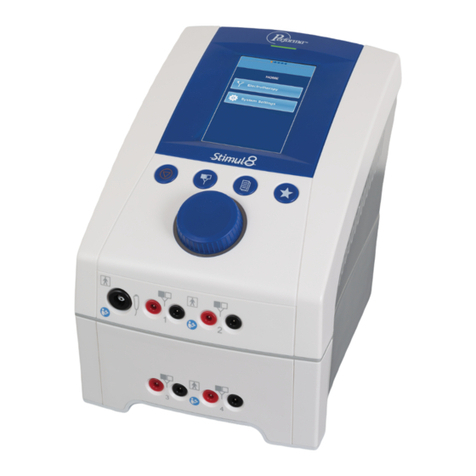
Performance Health
Performance Health Performa Combin8 Quattro user manual
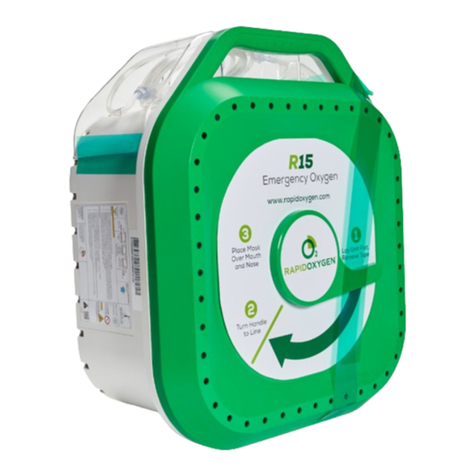
RAPIDOXYGEN
RAPIDOXYGEN R15 quick guide
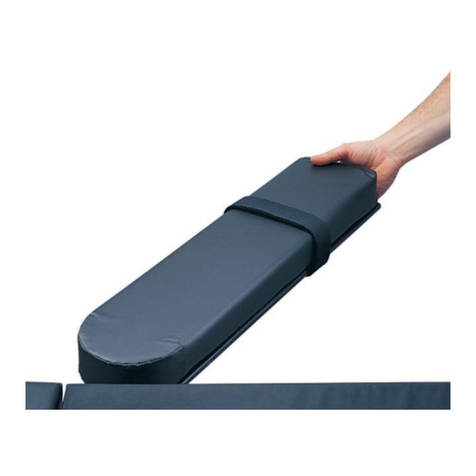
Skytron
Skytron F-ABSS Instructions for use
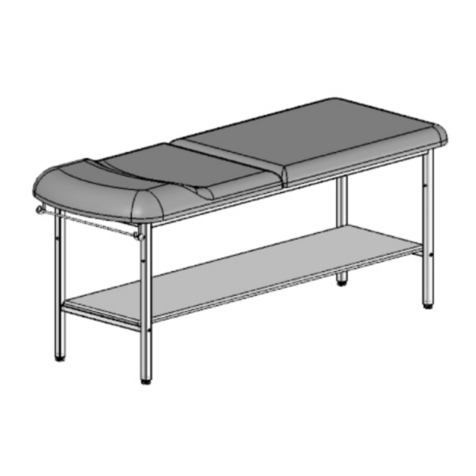
brewer
brewer BrewerElement manual
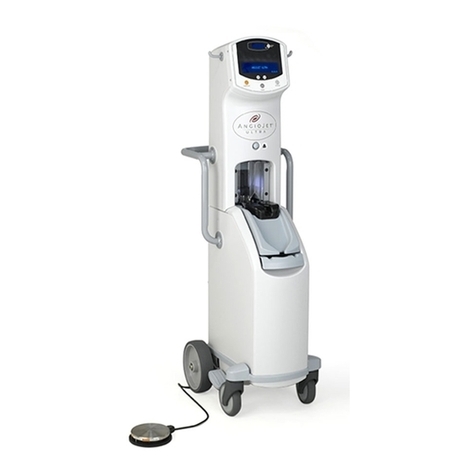
Boston Scientific
Boston Scientific AnjioJet Ultra 5000A Operator's manual

Jaco
Jaco Ultralite Power Blade Hot-Swap 300 Series manual

